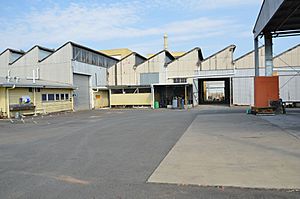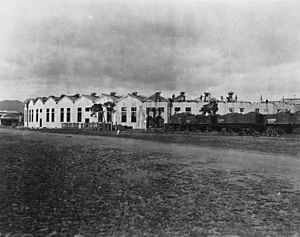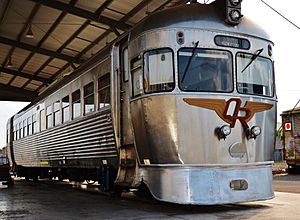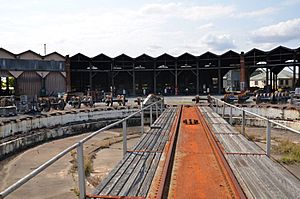Rockhampton Railway Workshops facts for kids
Quick facts for kids Rockhampton Railway Workshops |
|
|---|---|

Rockhampton Railway Workshops, 2011
|
|
| Location | 380 Bolsover Street, Depot Hill, Rockhampton Region, Queensland, Australia |
| Design period | 1900 - 1914 (early 20th century) |
| Built | 1915 - 1953 |
| Official name: Railway Workshops, Rockhampton Roundhouse, Rockhamtpton Railway Workshops | |
| Type | state heritage (built) |
| Designated | 21 August 1992 |
| Reference no. | 600783 |
| Significant period | 1915-1969 (historical) 1915-1950s (fabric) |
| Significant components | power house - electricity, track, shed/s, shop - carriage, shop - machine, machinery/plant/equipment - transport - rail, locomotive roundhouse, turntable, shop - paint, workshop |
| Lua error in Module:Location_map at line 420: attempt to index field 'wikibase' (a nil value). | |
The Rockhampton Railway Workshops is a special place in Depot Hill, Rockhampton Region, Queensland, Australia. It's a heritage-listed railway workshop that was built between 1915 and 1953. It's also known as the Rockhampton Roundhouse. This important site was added to the Queensland Heritage Register on August 21, 1992. Today, it still works as a railway workshop, fixing and maintaining trains.
Contents
History of the Rockhampton Railway Workshops
The first railway workshops in Rockhampton started in the late 1870s. They were located in a railway area near Denison, South, Campbell, and Stanley Streets. In the early 1900s, the workshops moved to a new spot. This move was part of a big plan to improve all the railway buildings in Rockhampton. Over the years, the workshops have been changed and updated many times. They are still used today to fix and maintain railway vehicles.
Why Queensland Chose Narrow Trains
In 1863, the government in Queensland decided to build its main railway lines using a narrow track width. This was a bit unusual because other parts of Australia used wider tracks. The idea was that narrow tracks would be cheaper to build. This decision helped Queensland save money when building its first railway network.
The first part of Queensland's railway opened in 1865, connecting Ipswich and Bigges Camp (now Grandchester). People in Rockhampton wanted their own railway too. They hoped a railway would help transport copper ore from the Peak Downs area and boost the local economy.
Growing the Central Railway Line
The first part of the Central Western railway line opened in 1867. It went from Rockhampton to Westwood, about 50 kilometres away. This first section didn't bring in much money because it stopped before crossing the mountains.
The line was later extended west, reaching Emerald in 1879 and Longreach in 1892. The Central Railway was based in Rockhampton. For a long time, it was separate from the railways in southern Queensland. They finally connected in 1903.
In 1895, a new railway called the Rockhampton Junction Railway was approved. This line, along with a new bridge, was built with two tracks. This was a first for Queensland outside of the Brisbane-Ipswich area. It was built to handle more traffic to the port at Broadmount and growing local travel in Rockhampton.
New Workshops and the Roundhouse
As the railway network grew, more trains meant more repairs were needed. New workshops and sheds were built to keep all the trains running.
A partial roundhouse was built in 1877. It had seven tracks for engines. But it quickly became too small. More stalls were added over the years. By the early 1900s, the old roundhouse was very crowded.
In 1909, plans were made for a much bigger new roundhouse. At the same time, the railway department wanted to expand the workshops. They bought Fitzroy Square, a park in Rockhampton. A lot of dirt was brought in to level the area for the new heavy machinery.
Building the new workshops was delayed by World War I because it was hard to get steel. The new locomotive roundhouse opened in late 1915. Other workshop buildings were finished one by one. By 1918, most of the new workshops were complete. The old workshops were then used to store train carriages.
The buildings had names that showed what they were used for. For example, the machine shop fixed small engine parts. The wheel repair shop fixed train wheels.
The Unique Rockhampton Roundhouse
The former steam locomotive running shed, known as the roundhouse, is a very important part of the workshops. It was built to store and fix steam locomotives used in the Central Division. This roundhouse is special because it's the only full-circle roundhouse ever built in Queensland for steam locomotives. It's also one of the last remaining full-circle roundhouses in Australia.
Construction of the roundhouse began in 1913. It was designed to have 52 stalls for locomotives. In the middle of the roundhouse was a large turntable. This turntable allowed engines to be moved into any stall for repairs or cleaning. The roundhouse was completed in November 1914. It was lit by electricity and had modern tools.
The roundhouse had five ways for trains to enter and exit. One main road was near the South Street gates. The foreman's office was also nearby. This office helped manage the movement of locomotives.
Even though it was built for 52 locomotives, the roundhouse was never completely full. Sometimes, bays not needed for engines were used by other workers, like tinsmiths. This was unique in Queensland.
A second roundhouse was planned for Rockhampton but never built. Instead, a modern coal stage was built in that area in 1934-35. In 1953, the turntable was replaced with a stronger one.
The End of Steam and New Beginnings
In the 1950s, new diesel-electric locomotives (DELs) arrived in Queensland. These new trains were easier to maintain and cleaner than steam locomotives. The first DELs came to Rockhampton in 1966. They were used for hauling coal.
As more DELs arrived, steam locomotives were slowly taken out of service. The last steam locomotive was repaired at the Rockhampton Workshops in 1969. The roundhouse officially stopped being a steam depot on September 29, 1969.
After the steam engines left, the roundhouse was used to repair wooden train wagons from 1969 to 1988. The roof was completely rebuilt in the late 1970s. In the 1980s, new equipment was installed to lift carriages. An office was also built inside one of the stalls.
Today, the Rockhampton Railway Workshops are still busy. They continue to fix and maintain railway vehicles. Queensland Rail plans to keep improving the site. Rockhampton is expected to become the main workshop for Queensland Rail in North Queensland in the future. The roundhouse is an important reminder of the steam train era.
What the Rockhampton Railway Workshops Look Like
The Railway Workshops are located at the corner of Bolsover and South streets in Rockhampton. The site has changed a lot over the years. It has many buildings and structures that are part of a working railway workshop. Here are some of the main buildings:
The Railway Roundhouse
The roundhouse is a very large circular building. It has an open space in the middle with a turntable. The roof is supported by round timber posts. The outside of the roundhouse is covered with corrugated iron sheets.
The building is divided into seven sections. Each section has seven or eight stalls, making a total of 52 stalls for engines. Each stall is like a small shed for a single train. Tracks spread out from the central turntable.
Inside, a two-story office building made of steel and glass has been built into 14 of the 52 bays.
Other Important Buildings
- Former Power House (Plant Maintenance Building): This building has a steel frame and is covered with corrugated iron. It has concrete floors.
- Former Machine Shop: Located east of the roundhouse, this building has steel columns and trusses. It's covered with corrugated iron and has both timber and concrete floors.
- Former Carriage Shop (now Machine Shop): This building has timber columns and steel roof trusses. It's covered with corrugated iron and has a concrete floor. It's connected to the former paint shop.
- Former Paint Shop (now Building Maintenance Shop): This building has a timber frame and is mostly covered with corrugated iron. It has a curved roof. It has timber windows and both concrete and timber floors.
Other Buildings at the Site
There are also other buildings, including:
- The former Apprentice Master's building, made of timber and weatherboard.
- A small toilet building covered in galvanised iron.
- The water fitters' store, also covered in galvanised iron.
- The occupational health centre and conference room, which are single-story timber buildings.
The railway workshops are surrounded by many other workshop buildings, sheds, and tracks. The site has been continuously updated for over 85 years.
Why the Rockhampton Railway Workshops Are Special
The Rockhampton Railway Workshops were added to the Queensland Heritage Register in 1992 for several important reasons:
Showing Queensland's Railway History
The workshops show how Queensland's railway system grew, especially in the Central Division based in Rockhampton. The large area, including the roundhouse, workshop buildings, and tracks, proves that Rockhampton was once a very important railway hub.
The workshops also show how trains changed from steam power to diesel-electric and electric power. It's a great example of how places adapted to new technology for maintaining trains.
A Rare Find
The Rockhampton Roundhouse is very special because it's the only full-circle roundhouse ever built in Queensland. It's also one of only two still existing in Australia. This makes it a rare and important example of this type of building.
What a Steam Locomotive Depot Looks Like
The roundhouse clearly shows what a steam locomotive running shed and maintenance depot should have. It has stalls under a roof, pits for inspection, a central turntable for turning engines, and tracks spreading out from the middle.
The former machine shop and electricians' shop are good examples of standard Queensland Railway designs. They are larger and taller than other buildings, often to hold cranes for heavy lifting. The former carriage shop also shows a typical Queensland Railway design.
These buildings help us understand how the complex operated in the early 20th century.
Beautiful and Important Design
The Rockhampton Roundhouse adds to the look of the railway workshop area. Its unique shape and how it has been adapted are important. It also stands out on Bolsover and South Streets.
The former machine and electricians' shops also add to the industrial look of Bolsover Street. The former carriage repair shop and paint shop are set back but still contribute to the street view. The former paint shop's curved roof makes it especially interesting to look at.
Connected to Queensland's Railway Growth
The Railway Workshops are important because they are linked to the steam locomotive era of Queensland Railways (1865-1969). They also represent a big period of growth for the railways between 1907 and 1920. The roundhouse was built at the same time as other large steam depots were being developed in Queensland.




